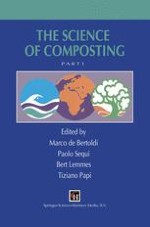1996 | OriginalPaper | Buchkapitel
The Influence of Compost and Sewage Sludge on Agricultural Crops
verfasst von : G. Baldoni, L. Cortellini, L. Dal Re
Erschienen in: The Science of Composting
Verlag: Springer Netherlands
Enthalten in: Professional Book Archive
Aktivieren Sie unsere intelligente Suche, um passende Fachinhalte oder Patente zu finden.
Wählen Sie Textabschnitte aus um mit Künstlicher Intelligenz passenden Patente zu finden. powered by
Markieren Sie Textabschnitte, um KI-gestützt weitere passende Inhalte zu finden. powered by
Compost, liquid and dewatered sludge from a sewage purification plant were spread each year on a three-course rotation (maize- wheat and sugarbeet) at two rates, with or without an extra inorganic NP supply. Sludge application was compared with a mineral fertilisation based on 4 rates of urea. In the first 6 years no toxicity to plants grown in compost or sludge plots was observed, even at the highest application rate (15 t DM ha-1). Sludges gave crop yields similar to those obtained with the highest rate of urea; compost yielded as the best inorganic fertilisation, which often corresponded to the lowest inorganic fertilisation. Most of the results of the organic materials could be ascribed to their N-NH4 content. The N in compost showed the lowest utilisation by crops (about 20% of urea-N), the highest in liquid sludge (30%) and intermediate values in dewatered material (27%). Because of negative effects of N relative to wheat lodging and quality of beet sugar, the disposal on agricultural land of liquid sludge requires particular care, whilst the application of dewatered sludge or compost appears much safer to crops.
